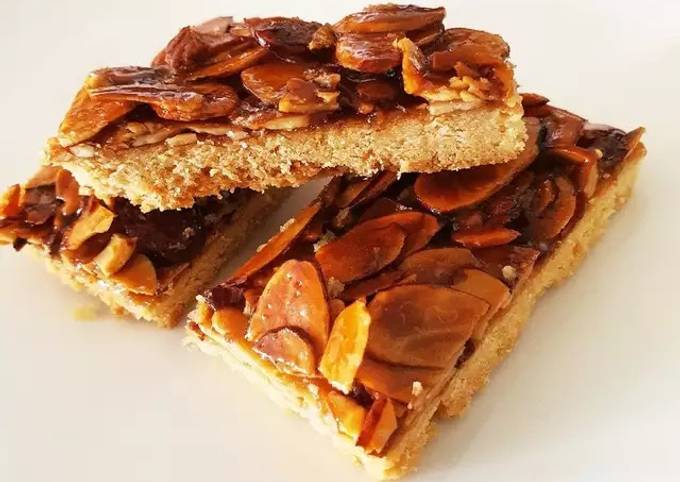Florentine Biscuits. Transfer to the baking sheet, and spoon some of the Florentine mixture onto each biscuit until it's all used up. Florentines Biscuits Crunchy and sweet, these Florentines Biscuits are a favourite classic cookie. These delightful almond cookies are filled with dried fruit and a simple caramel, and are baked until baked until golden and crisp.
 Pulse the almonds in a food processor until finely.
These Florentine lace cookies are simple to make and gorgeous to look at.
This cookie technique is versatile and adaptable to any kinds of nuts or chocolate.
You can cook Florentine Biscuits using 14 ingredients and 14 steps. Here is how you achieve that.
Pulse the almonds in a food processor until finely.
These Florentine lace cookies are simple to make and gorgeous to look at.
This cookie technique is versatile and adaptable to any kinds of nuts or chocolate.
You can cook Florentine Biscuits using 14 ingredients and 14 steps. Here is how you achieve that.
Ingredients of Florentine Biscuits
- You need of Sablé dough.
- You need 220 g of cake flour.
- It's 150 g of unsalted butter.
- Prepare 100 g of caster sugar.
- It's 1 of egg.
- Prepare 20 g of almond powder.
- You need 1 g of salt.
- You need of Appareil (topping).
- You need 60 g of granulated sugar.
- It's 40 g of unsalted butter.
- You need 60 g of heavy cream.
- It's 20 g of mizuame/honey/golden syrup/maple syrup.
- You need 20 g of mizuame/millet jelly.
- It's 150 g of sliced almond.
They also keep pretty well so they're perfect if you're looking for an idea for an edible holiday gift for any cookie lover on your list--just stack them up in a box and tie them with a bow! Florentine cookies are thin, crispy cookies made from a base of nuts (usually almonds or hazelnuts), fruits such as cherries and citrus, melted butter, and cream to create a candy-like base that's then baked. Once cool, Florentines are dipped or drizzled with melted chocolate for a finishing touch. Florentines are malleable and can be shaped after they come out of the oven.
Florentine Biscuits instructions
- Make sure all ingredients are at room temperature before starting. Sift the cake flour and the caster sugar separately..
- In a bowl, knead the butter until softened. Then, combine the caster sugar..
- Next, whisk the egg and divide into 3 portions. Pour one portion into the butter mixture, mix, then repeat with the other two portions. Keep mixing until it starts to look like mayonnaise..
- Combine the almond powder and salt in the butter mixture and mix..
- Add the cake flour into the mixture in 3 portions, mixing/folding in between (as if you’re cutting the dough)..
- Spread the dough between cling wrap (bottom) and parchment paper (top) and flatten the dough into a 28x28cm square using a rolling pin..
- Flip the dough around so the parchment paper is on the bottom and place in fridge to chill for a minimum of 1 hour..
- After the dough has had time to rest, preheat the oven to 180°C. Then, take the dough out from the fridge and poke holes in it using a fork..
- Lower the oven to 170°C and slightly bake the dough for 18 minutes..
- In the meantime, roast the sliced almonds by baking them at 170°C for 8 minutes..
- Once about 10 minutes of step 9 have passed, combine all the ingredients (except the sliced almonds) from the appareil section in a pot and simmer over medium heat for about 5 minutes..
- Then, after about 5 minutes, add the baked sliced almonds. The appareil mixture and the sablé dough should be finished at the same time..
- Next, spread the appareil mixture over the sablé dough..
- Bake the dough with the appareil for about 20 minutes at 160°C. Make sure to cut the florentines into squares before it completely cools down to prevent it from cracking. You should start cutting while it’s still warm..
The batter consists of cane sugar, light corn syrup (or honey or maple syrup), heavy cream, and butter. Why it is called a Florentine is still a mystery to be solved, but it is a very far cry from those delicate, lacy, petite Florentine biscuits, drizzled in melted chocolate. The essential ingredients of today's Florentine biscuits could not be less Tuscan: cream, butter and chocolate. It is essential to flatten them as thin as possible on the baking tray, rather than letting them spread out on their own,. Weigh butter, sugar and golden syrup into a small pan (preferably a non stick one - it will make cleaning up easier!) and heat gently to melt the butter.